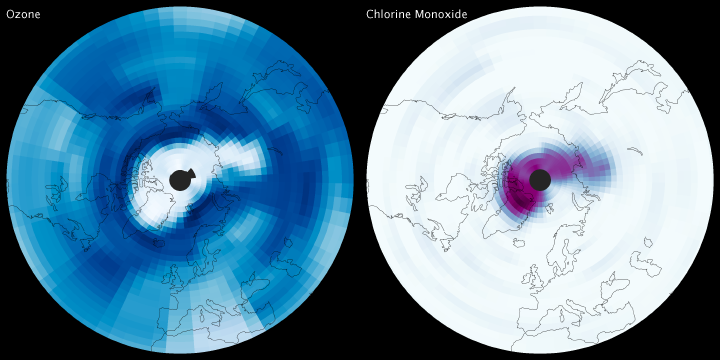


In March 2011, the Earth Observatory published images of a rare, deep depletion in the ozone layer over the Arctic. The images came from daily observations made by the Ozone Monitoring Instrument on NASA’s Aura satellite. A new study published in Nature uses a companion instrument on Aura, the Microwave Limb Sounder, to describe how and why the event looked a lot like the annual Antarctic “ozone hole.”
MLS looks through the edge of Earth’s atmosphere to measure gases, in this case ozone and chlorine monoxide, one of the most dominant ozone-destroying gases. The two maps above were made with data collected by MLS on March 18, 2011. In both cases, high concentrations of the gas are dark, while low concentrations are light. The left image shows high ozone concentrations over most of the planet, but very low concentrations—the ozone hole—over the Arctic. The right image shows the concentration of chlorine monoxide, which is concentrated over the Arctic where the ozone hole developed.
The correlation between high chlorine monoxide and the ozone hole is no accident. Sunlight provokes a series of chemical reactions between chlorine monoxide and ozone that ultimately destroys atmospheric ozone. What is unusual about March 2011 is the concentration of chlorine monoxide. The gas forms naturally in the atmosphere only in very cold conditions, where clouds or other particles are present in the atmosphere. Such conditions are extremely rare and are usually only found over Antarctica in the winter. In 2011, however, the Arctic stayed cold long enough for ozone-destroying gases to build in the atmosphere.
The research, published in Nature and led by Gloria Manney of NASA’s Jet Propulsion Laboratory, describes the conditions that allowed these high concentrations of chlorine monoxide to develop. First, the atmosphere between 15 and 23 kilometers in altitude (part of the stratosphere) was persistently cold for more than 100 days, a month longer than in any previously observed year. Temperatures were cold enough that polar stratospheric clouds formed over more of the Arctic atmosphere than ever seen before. The clouds provided a surface for stable chlorine gases to turn into reactive gases like chlorine monoxide.
The second factor was strong, swirling polar winds that isolate the Arctic. In the winter of 2010-11, this “polar vortex” was stronger than normal and persisted from December through March. The winds prevented Arctic air from mixing with the rest of the atmosphere, so chlorine monoxide built up in the region. Both the cold conditions and the winds persisted until sunlight returned to the Arctic in March, catalyzing the ozone-destroying reactions.
The difference between 2011 and other winters, which have also been extremely cold, is that temperatures were low enough to produce ozone-destroying forms of chlorine for a long time, says Manney. While it’s not clear why cold temperatures lasted so long in 2011, the fact that they did has some implications for the formation of an Arctic ozone hole in the future. If stratospheric temperatures drop as a result of climate change, Arctic ozone holes may happen more frequently. On the other hand, the study authors note, if the Montreal Protocol hadn’t limited the concentration of ozone-depleting gases in the atmosphere, then an Arctic ozone hole would form regularly, even in relatively warm winters.
NASA image by Eric Nash and Robert Simmon with data from the Aura Microwave Limb Sounder team. Caption by Holli Riebeek.